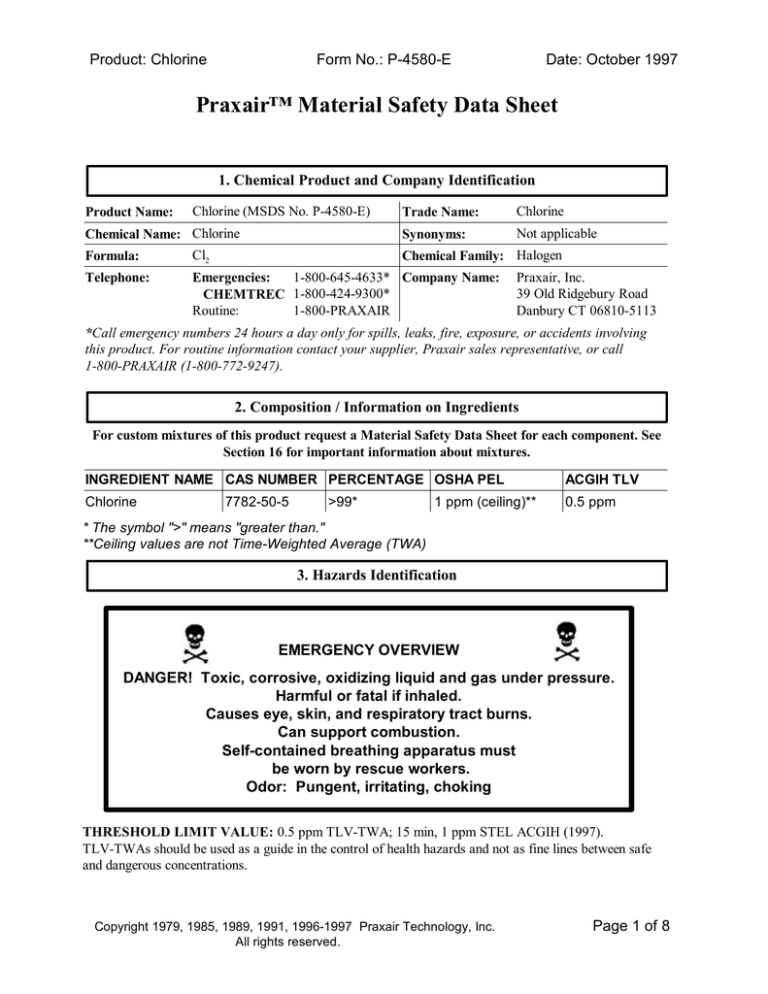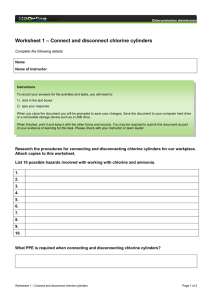
Product: Chlorine
Form No.: P-4580-E
Date: October 1997
Praxair™ Material Safety Data Sheet
1. Chemical Product and Company Identification
Product Name:
Chlorine (MSDS No. P-4580-E)
Chemical Name: Chlorine
Trade Name:
Chlorine
Synonyms:
Not applicable
Formula:
Cl2
Chemical Family: Halogen
Telephone:
1-800-645-4633* Company Name:
Emergencies:
CHEMTREC 1-800-424-9300*
1-800-PRAXAIR
Routine:
Praxair, Inc.
39 Old Ridgebury Road
Danbury CT 06810-5113
*Call emergency numbers 24 hours a day only for spills, leaks, fire, exposure, or accidents involving
this product. For routine information contact your supplier, Praxair sales representative, or call
1-800-PRAXAIR (1-800-772-9247).
2. Composition / Information on Ingredients
For custom mixtures of this product request a Material Safety Data Sheet for each component. See
Section 16 for important information about mixtures.
INGREDIENT NAME CAS NUMBER PERCENTAGE OSHA PEL
ACGIH TLV
Chlorine
0.5 ppm
7782-50-5
>99*
1 ppm (ceiling)**
* The symbol ">" means "greater than."
**Ceiling values are not Time-Weighted Average (TWA)
3. Hazards Identification
EMERGENCY OVERVIEW
DANGER! Toxic, corrosive, oxidizing liquid and gas under pressure.
Harmful or fatal if inhaled.
Causes eye, skin, and respiratory tract burns.
Can support combustion.
Self-contained breathing apparatus must
be worn by rescue workers.
Odor: Pungent, irritating, choking
THRESHOLD LIMIT VALUE: 0.5 ppm TLV-TWA; 15 min, 1 ppm STEL ACGIH (1997).
TLV-TWAs should be used as a guide in the control of health hazards and not as fine lines between safe
and dangerous concentrations.
Copyright 1979, 1985, 1989, 1991, 1996-1997 Praxair Technology, Inc.
All rights reserved.
Page 1 of 8
Product: Chlorine
Form No.: P-4580-E
Date: October 1997
EFFECTS OF A SINGLE (ACUTE) OVEREXPOSURE:
INHALATION – Overexposure to concentrations moderately above the Threshold Limit Value (TLV)
of 1 ppm irritates the eyes and respiratory tract. Very brief exposure to a concentration of 1000 ppm
may be fatal. Acts as asphyxiant at high concentrations. Inhalation of high concentrations (e.g., greater
than 15 ppm) causes choking, coughing, burning of the throat and severe irritation of the upper
respiratory tract; additionally, pulmonary edema, bronchitis, and pneumonitis may result. Lack of
oxygen can kill.
SKIN CONTACT – May severely irritate the skin, causing ulceration, chemical burns, and scarring.
Repeated exposure may produce dermatitis. With prolonged or widespread contact, the skin may absorb
potentially harmful amounts of material.
SWALLOWING – An unlikely route of exposure; this product is a gas at normal temperature and
pressure. May cause chemical burns of the mouth, esophagus, and stomach.
EYE CONTACT – May severely inflame the conjunctiva, injuring the lens, and causing corneal
opacity and iris atrophy.
EFFECTS OF REPEATED (CHRONIC) OVEREXPOSURE: Repeated exposure may cause
progressive lung dysfunction. Exposure may also corrode the teeth and may cause a chloracne-like
condition.
OTHER EFFECTS OF OVEREXPOSURE: None known.
MEDICAL CONDITIONS AGGRAVATED BY OVEREXPOSURE: Inhalation may aggravate
asthma and inflammatory or fibrotic pulmonary disease, as well as heart disease. Skin contact may
aggravate an existing dermatitis.
SIGNIFICANT LABORATORY DATA WITH POSSIBLE RELEVANCE TO HUMAN HEALTH
HAZARD EVALUATION: None known.
CARCINOGENICITY: Chlorine is not listed by NTP, OSHA, and IARC.
4. First Aid Measures
INHALATION: Immediately remove to fresh air. If not breathing, give artificial respiration. Qualified
personnel may give oxygen when necessary. Keep patient warm. Call a physician.
SKIN CONTACT: Avoid breathing vapor. Immediately flush affected areas with plenty of warm water
while removing contaminated clothing and shoes. Discard clothing and shoes. Call a physician.
SWALLOWING: An unlikely route of exposure. This product is a gas at normal temperature and
pressure.
EYE CONTACT: Immediately flush eyes thoroughly with warm water for at least 15 minutes. Hold the
eyelids open and away from the eyeballs to ensure that all surfaces are flushed thoroughly. See a physician,
preferably an ophthalmologist, immediately.
NOTES TO PHYSICIAN: Victims of overexposure should be kept under medical observation for 24 to
48 hours or 72 hours if exposure was severe. The hazards of this material are due mainly to its severe
irritant and corrosive properties on the skin and mucosal surfaces. Injury occurs mainly to the skin and
to mucosal surfaces. There is no specific antidote; and treatment should be directed at the control of
symptoms and clinical condition. Delayed pulmonary edema may occur.
Page 2 of 8
Product: Chlorine
Form No.: P-4580-E
Date: October 1997
5. Fire Fighting Measures
FLASH POINT
(test method)
Not applicable
AUTOIGNITION
TEMPERATURE
Not applicable
FLAMMABLE LIMITS
IN AIR, % by volume
LOWER
Not applicable
UPPER
Not applicable
EXTINGUISHING MEDIA: Oxidizing agent; may accelerate combustion. Use media appropriate
for surrounding fire.
SPECIAL FIRE FIGHTING PROCEDURES:
DANGER! Toxic, corrosive, oxidizing liquid and gas under pressure. Immediately evacuate all
personnel from danger area. Do not approach area without self-contained breathing apparatus and
protective clothing. Immediately cool cylinders with water spray from maximum distance, then move them
away from fire if without risk. If cylinders are leaking, reduce toxic vapors with water spray or fog. Do not
spray water directly on leak; this may cause leak to increase. Reverse flow into cylinders may cause
rupture. Shut off leak if without risk. On-site fire brigades must comply with OSHA 29 CFR 1910.156.
UNUSUAL FIRE AND EXPLOSION HAZARDS: Oxidizing agent, may accelerate combustion.
Contact with flammable materials may cause fire or explosion. Heat of fire can build pressure in cylinder
and cause it to rupture. No part of cylinder should be subjected to a temperature higher than 125°F (52°C).
Chlorine cylinders are equipped with a pressure relief device. (Exceptions may exist where
authorized by DOT.) Chlorine may react violently with other materials at temperatures above 483°F
(250.5°F). (See "Incompatibility," section 10.) Vapors are extremely irritating and may burn skin and eyes
on contact.
HAZARDOUS COMBUSTION PRODUCTS: None known.
6. Accidental Release Measures
STEPS TO BE TAKEN IF MATERIAL IS RELEASED OR SPILLED:
DANGER! Toxic, corrosive, oxidizing liquid and gas under pressure. Immediately evacuate all
personnel from danger area. Do not approach area without self-contained breathing apparatus and
protective clothing. Oxidizing agent; contact with flammable materials may cause fire or explosion. Do not
spray water directly on source of flow or leak; this may accelerate flow. Reduce vapors with fog or fine
water spray. Reverse flow into cylinder may cause rupture. Shut off flow if without risk. Ventilate area or
move cylinder to a well-ventilated area. Prevent runoff from contaminating surrounding environment.
Toxic, corrosive vapors may spread from spill. Before entering area, especially a confined area, check
atmosphere with an appropriate device.
WASTE DISPOSAL METHOD: Prevent waste from contaminating the surrounding environment. Keep
personnel away. Discard any product, residue, disposable container or liner in an environmentally
acceptable manner, in full compliance with federal, state, and local regulations. If necessary, call your local
supplier for assistance.
7. Handling and Storage
PRECAUTIONS TO BE TAKEN IN STORAGE: Store and use with adequate ventilation, away from
oil, grease, and other combustibles. Firmly secure cylinders upright to keep them from falling or being
knocked over. Screw valve protection cap firmly in place by hand. Store only where temperature will not
Page 3 of 8
Product: Chlorine
Form No.: P-4580-E
Date: October 1997
exceed 125°F (52°C). Store full and empty cylinders separately. Use a first-in, first-out inventory system to
prevent storing full cylinders for long periods.
PRECAUTIONS TO BE TAKEN IN HANDLING: Protect cylinders from damage. Use a suitable hand
truck to move cylinders; do not drag, roll, slide, or drop. Never attempt to lift a cylinder by its cap; the cap
is intended solely to protect the valve. Never insert an object (e.g., wrench, screwdriver, pry bar) into cap
openings; doing so may damage the valve and cause a leak. Use an adjustable strap wrench to remove
over-tight or rusted caps. Open valve slowly. If valve is hard to open, discontinue use and contact your
supplier. For other precautions in using chlorine, see section 16.
For additional information on storage and handling, refer to Compressed Gas Association (CGA) pamphlet
P-1, "Safe Handling of Compressed Gases in Containers," available from the CGA. Refer to section 16 for
the address and phone number along with a list of other available publications.
8. Exposure Controls/Personal Protection
VENTILATION/ENGINEERING CONTROLS:
LOCAL EXHAUST – corrosion-resistant system is acceptable.
MECHANICAL (general) – Inadequate. See SPECIAL, below..
SPECIAL – Use only in a closed system. Corrosion-resistant, forced-draft fume hood is preferred
OTHER - See special.
RESPIRATORY PROTECTION: Select per OSHA 29 CFR 1910.134 and ANSI Z88.2. Use
air-supplied respirators for concentrations up to 10 times the applicable permissible exposure limit. For
concentrations up to 50 times the applicable exposure limit, use a NIOSH/MSHA-approved respirator with
a full face piece or use a self-contained breathing apparatus. For higher concentrations, use only a full-face,
self-contained breathing apparatus operated in the pressure demand mode.
PROTECTIVE GLOVES: Neoprene.
EYE PROTECTION: Wear safety glasses when handling cylinders; vapor-proof goggles and a face
shield during cylinder changeout or wherever contact with product is possible. Select per OSHA 29 CFR
1910.133.
OTHER PROTECTIVE EQUIPMENT: Metatarsal shoes for cylinder handling and protective clothing
where needed. Select per OSHA 29 CFR 1910.132 and 1910.133. Regardless of protective equipment,
never touch live electrical parts.
9. Physical and Chemical Properties
MOLECULAR WEIGHT: 70.906
EXPANSION RATIO: Not applicable
SPECIFIC GRAVITY (Air=1): 2.485 At 32°F
(0°C)
SOLUBILITY IN WATER: Slight
GAS DENSITY: At 32°F (0°C) 0.20057 lb/ft3
(3.2128 kg/m3)
VAPOR PRESSURE: At 68°F (20°C): 85.3
psig (588.13 KPa)
PERCENT VOLATILES BY VOLUME: 100
EVAPORATION RATE (Butyl Acetate=1):
High
BOILING POINT, 760 mm. Hg: -29.15°F
(-33.97°C)
pH: Not applicable
Page 4 of 8
Product: Chlorine
Form No.: P-4580-E
Date: October 1997
MELTING POINT (1 atm): -149.76°F (-100.97°C)
APPEARANCE, ODOR, AND STATE: Greenish-yellow gas at normal temperature and
pressure; pungent, irritating, choking odor.
10. Stability and Reactivity
STABILITY:
Unstable
Stable
X
INCOMPATIBILITY (materials to avoid): Chlorine reacts violently with most materials including
metals (e.g., aluminum, copper, brass), especially flammable materials and other reducing agents,
including carbon steel, at temperatures above 483°F (250.5°F).
HAZARDOUS DECOMPOSITION PRODUCTS: Burning may produce toxic fumes of
chlorides.
HAZARDOUS POLYMERIZATION:
May Occur
Will Not Occur
X
CONDITIONS TO AVOID: None known.
11. Toxicological Information
LC50 = 293 ppm (1 hr. rat)
12. Ecological Information
Chlorine does not contain any Class I or Class II ozone-depleting chemicals. Chlorine is not listed as a
marine pollutant by DOT.
13. Disposal Considerations
WASTE DISPOSAL METHOD: Do not dispose of unused quantities. Return cylinder to supplier.
14. Transport Information
DOT/IMO SHIPPING NAME: Chlorine
HAZARD CLASS: 2.3
IDENTIFICATION NUMBER: UN 1017
PRODUCT RQ: 10 lbs (4.54 kg)
SHIPPING LABEL(s): TOXIC GAS,
CORROSIVE, OXIDIZER
PLACARD (When required): TOXIC GAS,
CORROSIVE, OXIDIZER
SPECIAL SHIPPING INFORMATION: Cylinders should be transported in a secure position, in a
well-ventilated vehicle. Cylinders transported in an enclosed, nonventilated compartment of a vehicle can
present serious safety hazards.
Additional Marking Requirement: Inhalation Hazard
Shipment of compressed gas cylinders that have been filled without the owner's consent is a violation of
federal law [49 CFR 173.301(b)].
Page 5 of 8
Product: Chlorine
Form No.: P-4580-E
Date: October 1997
15. Regulatory Information
The following selected regulatory requirements may apply to this product. Not all such requirements are
identified. Users of this product are solely responsible for compliance with all applicable federal, state, and
local regulations.
U.S. FEDERAL REGULATIONS:
EPA (Environmental Protection Agency)
CERCLA: Comprehensive Environmental Response, Compensation, and Liability Act of
1980 (40 CFR Parts 117 and 302):
Reportable Quantity (RQ): 10 lbs (4.54 kg)
SARA: Superfund Amendment and Reauthorization Act:
SECTIONS 302/304: Require emergency planning based on Threshold Planning Quantity
(TPQ) and release reporting based on Reportable Quantities (RQ) of extremely hazardous
substances (40 CFR Part 355):
Threshold Planning Quantity (TPQ): 100 lbs (45.4 kg)
Extremely Hazardous Substances (40 CFR 355): None
SECTIONS 311/312: Require submission of Material Safety Data Sheets (MSDSs) and
chemical inventory reporting with identification of EPA hazard categories. The hazard
categories for this products are as follows:
IMMEDIATE: Yes
DELAYED: Yes
PRESSURE: Yes
REACTIVITY: No
FIRE: Yes
SECTION 313: Requires submission of annual reports of release of toxic chemicals that
appear in 40 CFR Part 372.
Chlorine requires reporting under Section 313.
40 CFR 68: Risk Management Program for Chemical Accidental Release Prevention:
Requires development and implementation of risk management programs at facilities that
manufacture, use, store, or otherwise handle regulated substances in quantities that exceed
specified thresholds.
Chlorine is listed as a regulated substance in quantities of 2500 lbs (1134 kg) or greater.
TSCA: Toxic Substances Control Act: Chlorine is listed on the TSCA inventory.
OSHA (OCCUPATIONAL SAFETY AND HEALTH ADMINISTRATION):
29 CFR 1910.119: Process Safety Management of Highly Hazardous Chemicals: Requires
facilities to develop a process safety management program based on Threshold Quantities (TQ)
of highly hazardous chemicals.
Chlorine is listed in Appendix A as a highly hazardous chemical in quantities of 1500
pounds (680 kg) or greater.
Page 6 of 8
Product: Chlorine
Form No.: P-4580-E
Date: October 1997
STATE REGULATIONS:
CALIFORNIA: This product is not listed by California under the Safe Drinking Water Toxic
Enforcement Act of 1986 (Proposition 65).
PENNSYLVANIA: This product is subject to the Pennsylvania Worker and Community
Right-To-Know Act (35 P.S. Sections 7301-7320).
16. Other Information
Be sure to read and understand all labels and instructions supplied with all containers of this product.
OTHER HAZARDOUS CONDITIONS OF HANDLING, STORAGE, AND USE: Toxic, corrosive,
nonflammable liquid and gas under pressure. Do not breathe gas. Do not get vapors or liquid in eyes, on
skin, or on clothing. (See section 3.) Have safety showers and eyewash fountains immediately available.
Use piping and equipment adequately designed to withstand pressures to be encountered. Use only in a
closed system constructed of corrosion- resistant materials. Close valve after each use; keep closed even
when empty. Prevent reverse flow. Reverse flow into cylinder may cause rupture. Use a check valve or
other protective device in any line or piping from the cylinder. Store and use with adequate ventilation at
all times. Oxidizing agent. Store away from flammable materials. Keep oil, grease and flammable
materials away. Never work on a pressurized system. If there is a leak, close the cylinder valve. Blow the
system down in an environmentally safe manner in compliance with all federal, state, and local laws, then
repair the leak. Never ground a compressed gas cylinder or allow it to become part of an electrical
circuit.
NOTE: Prior to using any plastics, confirm their compatibility with chlorine.
Recommended Equipment: In semiconductor process gas and other suitable applications, Praxair
recommends the use of engineering controls such as gas cabinet enclosures, automatic gas panels (used to
purge systems on cylinder changeout), excess-flow valves throughout the gas distribution system, double
containment for the distribution system, and continuous gas monitors.
MIXTURES: When you mix two or more gases or liquefied gases, you can create additional, unexpected
hazards. Obtain and evaluate the safety information for each component before you produce the mixture.
Consult an industrial hygienist, or other trained person when you evaluate the end product. Remember,
gases and liquids have properties that can cause serious injury or death.
HAZARD RATING SYSTEMS:
NFPA RATINGS:
Revised
HMIS RATINGS:
HEALTH
=4
HEALTH
=2
FLAMMABILITY
=0
FLAMMABILITY = 0
REACTIVITY
=0
REACTIVITY
SPECIAL
OX
=0
Page 7 of 8
Product: Chlorine
Form No.: P-4580-E
Date: October 1997
STANDARD VALVE CONNECTIONS FOR U.S. AND CANADA:
THREADED:
CGA-660 limited-standard for Specialty Gas Industry
PIN-INDEXED YOKE:
Not applicable
ULTRA-HIGH-INTEGRITY
CONNECTION:
CGA-728 standard, 634 limited-std (obsolete 1/1/98)
Use the proper CGA connections. DO NOT USE ADAPTERS. Additional standard industrial
yoke connections apply. See CGA Pamphlet V-1 listed below.
Ask your supplier about free Praxair safety literature as referenced on the label for this product; you may
also obtain copies by calling 1-800-PRAXAIR. Further information about chlorine can be found in the
following pamphlets published by the Compressed Gas Association, Inc. (CGA), 1725 Jefferson Davis
Highway, Arlington, VA 22202-4102, Telephone (703) 412-0900.
P-1
V-1
Safe Handling of Compressed Gases in Containers
Compressed Gas Cylinder Valve Inlet and Outlet Connections
Handbook of Compressed Gases, Third Edition
Praxair asks users of this product to study this Material Safety Data Sheet (MSDS) and become aware of
product hazards and safety information. To promote safe use of this product, a user should (1) notify
employees, agents and contractors of the information on this MSDS and of any other known product
hazards and safety information, (2) furnish this information to each purchaser of the product, and (3) ask
each purchaser to notify its employees and customers of the product hazards and safety information.
The opinions expressed herein are those of qualified experts within Praxair, Inc.
We believe that the information contained herein is current as of the date of this
Material Safety Data Sheet. Since the use of this information and the conditions of
use of the product are not within the control of Praxair, Inc., it is the user's
obligation to determine the conditions of safe use of the product.
Praxair MSDSs are furnished on sale or delivery by Praxair or the independent distributors and
suppliers who package and sell our products. To obtain current Praxair MSDSs for these products,
contact your Praxair sales representative or local distributor or supplier. If you have questions regarding
Praxair MSDSs, would like the form number and date of the latest MSDS, or would like the names of
the Praxair suppliers in your area, phone or write the Praxair Call Center (Phone: 1-800-PRAXAIR;
Address: Praxair Call Center, Praxair, Inc., PO Box 44, Tonawanda, NY 14150-7891).
Praxair is a trademark of Praxair Technology, Inc.
Praxair, Inc.
39 Old Ridgebury Road
Danbury CT 06810-5113
Page 8 of 8
Printed in USA
Revised




